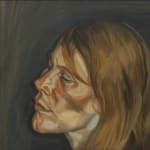-
Lucian Freud 1922-2011
Woman with Fair Hair-Portrait II, 1962-3oil on canvas
23 1/4 x 23 1/4 inches / 59 x 59 cm‘My object in painting pictures is to try and move the senses by giving an intensification of reality. Whether this can be achieved depends on how intensely the painter understands...‘My object in painting pictures is to try and move the senses by giving an intensification of reality. Whether this can be achieved depends on how intensely the painter understands and feels for the person or object of his choice. The subject must be kept under closest observation: if this is done, day and night, the subject – he, she, or it – will eventually reveal the all without which selection itself is not possible; they will reveal it, through some and every facet of their lives, or lack of life, through movements and attitudes, through every variation from one to another’ [1]
Woman with Fair Hair - Portrait II is one of several iconic portraits of Lady Jane Willoughby painted by Lucian Freud in the 1960s, perhaps the best known of which is Woman in a Fur Coat, 1967-8. A long-term girlfriend of the artist, Jane was one of the most important women in Freud’s life and they remained close for over fifty years. Throughout his career, Freud chose to paint the people he knew well, although he famously claimed that his work was “purely autobiographical”, explaining, “I use the people to invent my pictures with, and I can work more freely when they are there.” [2]
In the early 1960s, emboldened by the visceral approach of Bacon, Freud moved away from the meticulous, sable-brush technique he had perfected in the 1950s, adopting a looser, more emphatic application of paint. He switched to using hog hair brushes, applying his oil in thick, broad strokes, necessitating he work on a larger scale.
Here, Freud focuses on the sitter’s head, which fills the canvas, framed only by brushstrokes of dark grey, green and muddied ochre, which serve to heighten the sitter’s glowing, almost translucent skin. Jane’s head is tilted up and forward at an angle which allows Freud to scrutinize the musculature of the face, while her gaze is averted in a gesture of self-preservation. There is a palpable sense of the movement of paint, directed by Freud in energetic sweeps and strokes. Despite the energy and vigour of these marks, the overall feeling in this painting is the result of quiet contemplation on the part of both artist and sitter, a mutual understanding and a collaboration in the creation of a portrait of stature and depth.
1 Lucian Freud, ‘Some Thoughts on Painting’, Encounter, London, July 1954
2 The artist quoted in Sarah Howgate, Michael Auping, John Richardson, Lucian Freud: Portraits, National Portrait Gallery, London, 2012, p14
Provenance
Marlborough Fine Art, Ltd., London
Lord Glenconner
Lady Willoughby de Eresby
Private Collection, UK
Offer Waterman, London
Private Collection, UK
Exhibitions
London, Marlborough Fine Art, Lucian Freud Recent Work, October 1963, cat no. 17, illus b/w
New York, Ordovas, London Painters, 3 November 2017- 18 January 2018, illus colour, p.53
Join our mailing list
* denotes required fields
We will process the personal data you have supplied to communicate with you in accordance with our Privacy Policy. You can unsubscribe or change your preferences at any time by clicking the link in our emails.



